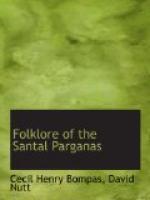If a child is born on the day before the new moon the following ceremony is observed. After bathing the child they place an old broom in the mother’s arms instead of the child; then the mother takes the child and throws it out on the dung heap behind the house. The midwife then takes an old broom and an old winnowing fan and sweeps up a little rubbish on to the fan and takes it and throws it on the dung hill; there she sees the child and calls out. “Here is a child on the dung heap” then she pretends to sweep the child with the broom into the winnowing fan and lifts it up and carries it into the house; and asks the people of the house whether they will rear it. They ask what wages she will give them and she promises to give them a heifer when the child is grown up.
If this is not done the child will be unlucky when it grows up; if it is a boy, however often he may marry, his wife will die and so, if it is a girl, her husbands will die.
Another fact is that they always shave a child’s head for the first two times during the same moon; if it is shaved first during one moon and then during the following moon; it will always have a headache once a month.
Similarly when they tie the knots in a string to fix the date of a wedding the wedding must take place in the lunar month in which the knots are tied or else the children born of the marriage will die.
CLXXI. Illegitimate Children.
If a woman has an illegitimate child and from fear or shame will not name its father the bastard is called a child of Chando. At its birth there is no assembly of the neighbours; its head is not ceremonially shaved and there is no narta ceremony. The midwife does what is necessary; and the child is admitted into no division of the tribe. If it is a boy it is called Chandu or Chandrai or sometimes Birbanta and if a girl Chandro or Chandmuni or perhaps Bonela. Sometimes after the child is born the mother will under seal of secrecy tell its father’s name to her mother or the midwife; and then between themselves they will call the child by a name taken from the father’s family but they will never tell it to anyone else. When the child grows up he is given some nickname and if he turns out well and is popular his name is often changed again and he is recognised as a Santal.
Often if a father will not acknowledge a child the mother will strangle it at birth and bury the body. Men who practise sorcery dig up the bones of such murdered infants and use them as rattles when doing their sorceries and are helped by them to deceive people.
CLXXII. The Dead.
Santals are very much afraid of burial grounds; for dead men become bongas and bongas eat men. If a man meet such a bonga in a burial ground it is of little use to fight for the bonga keeps on changing his shape. He may first appear as a man and then change into a leopard or a bear or a pig or a cat: very few escape when attacked by such a being.




